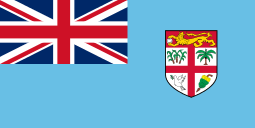World Rugby Women's Sevens Series
|
Current season, competition or edition: | |
 | |
| Sport | Rugby union |
|---|---|
| Founded | 2012 |
| No. of teams | 12 |
| Country | Worldwide |
| Most recent champion(s) |
|
| Most titles |
|
The World Rugby Women's Sevens Series, known as the HSBC Women's World Rugby Sevens Series for sponsorship reasons,[1] is a series of international rugby union sevens tournaments for women's national teams run by World Rugby. The inaugural series was held in 2012–13 as the successor to the IRB Women's Sevens Challenge Cup held the previous season.
The series, the women's counterpart to the HSBC World Sevens Series, provides elite-level women's competition between rugby nations. As with the men's Sevens World Series, teams compete for the title by accumulating points based on their finishing position in each tournament.
History
The first 2012–13 series consisted of four tournaments on three continents. The first two events were hosted by the United Arab Emirates (specifically Dubai) and the United States, both of which host events in the men's version. The other two events were hosted by China and the Netherlands.
For the second series in 2013–14, five tournaments took place; a sixth had initially been announced, but never materialized. All nations that hosted events in 2012–13 hosted in the second season, with the added event hosted by Brazil.[2]
The series expanded to six events for 2014–15. The Dubai, Brazil, USA, and Netherlands events remained on the schedule. China was not on the 2014–15 schedule. New rounds of the series were launched in Canada (specifically in Greater Victoria) and London.[3] Initially, the 2015–16 series was announced with only four events, with London and the Netherlands dropping from the schedule, but a fifth event was eventually added, hosted by France (specifically in Clermont-Ferrand).
Tournaments
Current events
For the 2016–17 season, six tournaments have been confirmed.[4][5]
| Event | Stadium (Capacity) | City | Joined |
|---|---|---|---|
| | The Sevens (50,000) | Dubai | 2012–13 |
| | Sydney Football Stadium (45,500) | Sydney | 2016–17 |
| | Sam Boyd Stadium (35,500) | Las Vegas | 2012–13 |
| | Honjō Athletic Stadium (10,202) | Kitakyushu | 2016–17 |
| | Westhills Stadium (1,600) | Langford (Victoria) | 2014–15 |
| | Stade Gabriel Montpied (10,607) | Clermont-Ferrand | 2015–16 |
Previous events
| Event | Stadium (Capacity) | City | Joined | Ended |
|---|---|---|---|---|
| | Guangzhou University City Stadium (50,000) | Guangzhou | 2012–13 | 2013–14 |
| | Arena Barueri (35,000) | Barueri (São Paulo) | 2013–14 | 2015–16 |
| | Twickenham Stoop (14,800) | London | 2014–15 | |
| | NRCA Stadium (10,000) | Amsterdam | 2012–13 | 2014–15 |
Sponsorship
Unlike the men's Sevens Series, which has enjoyed title sponsorship by banking giant HSBC in recent years, the Women's Sevens Series did not have a title sponsor until 2015–16. HSBC is now the title sponsor of both the men's and women's series.
Results by season
| Season | Rounds | Champion | Second | Third | Fourth | Fifth | Sixth |
|---|---|---|---|---|---|---|---|
| 2012–13 | 4 | |
|
|
|
|
|
| 2013–14 | 5 | |
|
|
|
|
|
| 2014–15 | 6 | |
|
|
|
|
|
| 2015–16 | 5 | |
|
|
|
|
|
Format
Sevens is a stripped-down version of rugby union, invented in Scotland in the 19th century, with seven players each side on a normal-sized field. Games are much shorter, lasting only seven or ten minutes each half, and tend to be very fast-paced, open affairs. The game is quicker and higher-scoring than 15-a-side rugby and the rules are far simpler, which explains part of its appeal. It also gives players the space for superb feats of individual skill. Sevens is traditionally played in a two-day tournament format.
Prior to the inaugural season, a group of "core teams" that are guaranteed places in all series events was announced. This concept is taken directly from the men's series. Unlike the men's series, which features 15 core teams as of the 2012–13 season, the women's series began with only six. The initial core teams were:[6]
For the 2013–14 series, the number of core teams was increased to eight, all reached the quarter final from the 2013 Rugby World Cup Sevens:[2]
![]() Brazil was invited to participate in all events for the 2013–14 series. This was part of an IRB initiative to help jump-start women's rugby development in the country, which is set to host the 2016 Summer Olympics.[2]
Brazil was invited to participate in all events for the 2013–14 series. This was part of an IRB initiative to help jump-start women's rugby development in the country, which is set to host the 2016 Summer Olympics.[2]
For the 2014–15 series, the number of core teams increased to 11, and qualification was extensively revamped, changing to a system more similar to that currently used in the men's World Series. The top seven teams in the 2013–14 series retained core team status. Four additional core teams were determined in a 12-team qualifying tournament held in Hong Kong on 12–13 September 2014.[7] World Rugby did not initially announce full details of the qualification system for future series, but eventually determined that the top nine teams from the 2014–15 series would retain their status for 2015–16, with a world qualifier following in September 2015.[8]
Following the 2014–15 qualifying tournament, the core teams were:
 Australia
Australia Canada
Canada China – relegated to 2015 qualifier
China – relegated to 2015 qualifier England
England France
France Fiji
Fiji New Zealand
New Zealand Russia
Russia South Africa – relegated to 2015 qualifier
South Africa – relegated to 2015 qualifier Spain
Spain United States
United States
The current roster of core teams, following the 2015–16 qualifier held in Dublin, is:[9]
 Australia
Australia Canada
Canada England
England France
France Fiji
Fiji Ireland – finalist in 2015 qualifier
Ireland – finalist in 2015 qualifier Japan – winner of 2015 qualifier
Japan – winner of 2015 qualifier New Zealand
New Zealand Russia
Russia Spain
Spain United States
United States
Unlike the men's series, which features 16, 20, or 28 teams in each tournament, the women's series features 12 teams in each tournament. The remaining participants are invited on the basis of regional tournament rankings.[6]
Each tournament uses a format similar to that of the men's series, adjusted for the lower number of teams, with pool play followed by three separate knockout tournaments. World Rugby did not initially announce whether the women's series would follow the men's practice of conducting tournaments for multiple trophies of varying prestige. In the end, it chose to follow the men's practice, although with minor adjustments. Since each women's tournament has only 12 teams, as opposed to the 16 that compete for series points in all events of the men's series, the fourth-level Shield trophy is not contested in the women's series. Both series offer a Cup trophy to the overall winner, with lower-level Plate and Bowl trophies also contested.
One significant difference between tournament formats in the men's and women's series is that in the women's series, the losers of the Plate and Bowl semi-finals play in classification matches.[10] In the men's series, the only semi-final losers who play a classification match are those in the Cup tournament.[11]
Player awards by season
| Season | Rounds | Top Scorer | Most tries | Player of the Year |
|---|---|---|---|---|
| 2012–13 | 4 | |
|
|
| 2013–14 | 5 | |
|
|
| 2014–15 | 6 | |
|
|
| 2015–16 | 5 | |
|
TBD |
Points schedule
The season championship will be determined by points earned in each tournament. The points schedule is similar to that of the men's Series, with the differences noted in the previous section.[10][11]
| Status | Placement | Points |
|---|---|---|
| Cup winner | 1st | 20 |
| Cup runner-up | 2nd | 18 |
| Cup third-place play-off winner | 3rd | 16 |
| Cup third-place play-off loser | 4th | 14 |
| Plate winner | 5th | 12 |
| Plate runner-up | 6th | 10 |
| Plate seventh-place play-off winner | 7th | 8 |
| Plate seventh-place play-off loser | 8th | 6 |
| Bowl winner | 9th | 4 |
| Bowl runner-up | 10th | 3 |
| Bowl 11th-place play-off winner | 11th | 2 |
| Bowl 11th-place play-off loser | 12th | 1 |
Should teams finish equal on series points at the end of the season, the tiebreakers are the same as those in the men's series:[10]
- Overall scoring differential in the season.
- Total try count in the season.
- If neither produces a winner, the teams are tied.
See also
Notes and references
- ↑ "HSBC partners with World Rugby for record-breaking sevens properties" (Press release). World Rugby. 30 June 2015. Retrieved 24 August 2015.
- 1 2 3 "Schedule announced for 2013/14 Women's Series" (Press release). International Rugby Board. 22 August 2013. Retrieved 2 October 2013.
- ↑ "Host cities announced for women's series" (Press release). International Rugby Board. 31 July 2014. Retrieved 1 August 2014.
- ↑ "HSBC World Rugby Women's Sevens Series to kick-off in Dubai". Seven Days. 28 August 2016. Archived from the original on 30 August 2016. Retrieved 30 August 2016.
- ↑ "Las Vegas to host Women's Sevens Series round in 2017". World Rugby. 29 November 2016. Archived from the original on 29 November 2016.
- 1 2 "IRB announces Women's Sevens World Series" (Press release). International Rugby Board. 4 October 2012. Archived from the original on 19 October 2014. Retrieved 4 October 2012.
- ↑ "Women's Sevens Series places up for grabs" (Press release). International Rugby Board. 8 July 2014. Retrieved 11 August 2014.
- ↑ "Team GB secure Olympic qualification as Canada claim Amsterdam Sevens" (Press release). World Rugby. 23 May 2015. Retrieved 26 May 2015.
- ↑ "Japan and Ireland qualify for Women's Sevens Series" (Press release). World Rugby. 20 August 2015. Retrieved 24 August 2015.
- 1 2 3 "Women's Sevens Series Tournament Rules". World Rugby. Retrieved 7 April 2015.
- 1 2 "IRB Sevens World Series: Rules". International Rugby Board. Retrieved January 4, 2013.